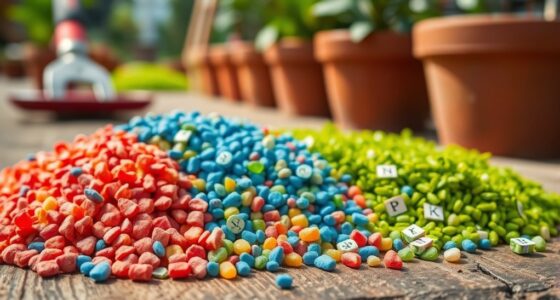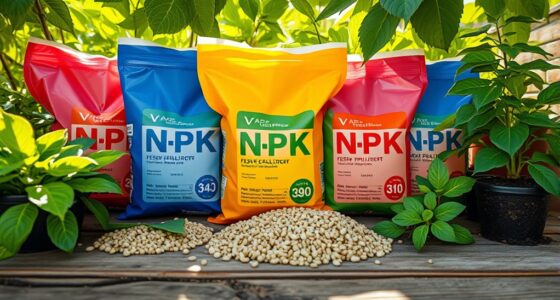Miracid is specially formulated for acid-loving plants, helping to lower and maintain soil pH while providing essential nutrients like iron, making it ideal for plants like azaleas and blueberries. Miracle-Gro is a general-purpose fertilizer that promotes rapid growth but usually isn’t designed for acidity management unless labeled otherwise. If you’re unsure which to choose, exploring their differences and how they fit your garden’s needs can help you support healthy, thriving acid-loving plants.
Key Takeaways
- Miracid is specially formulated to lower soil pH, making it ideal for acid-loving plants, while Miracle-Gro is generally neutral or slightly alkaline.
- Miracid contains nutrients and trace minerals designed to maintain acidity and support acid-loving plant health.
- Miracle-Gro may require additional pH adjustment to be suitable for acid-loving plants, as it is primarily a general-purpose fertilizer.
- Miracid is often more affordable per pound and available at specialty garden centers, whereas Miracle-Gro is widely accessible at big-box stores.
- For optimal results, use Miracid for pH management and acid-loving plants, supplementing with organic amendments if needed for soil health.
Overview of Miracid and Miracle-Gro
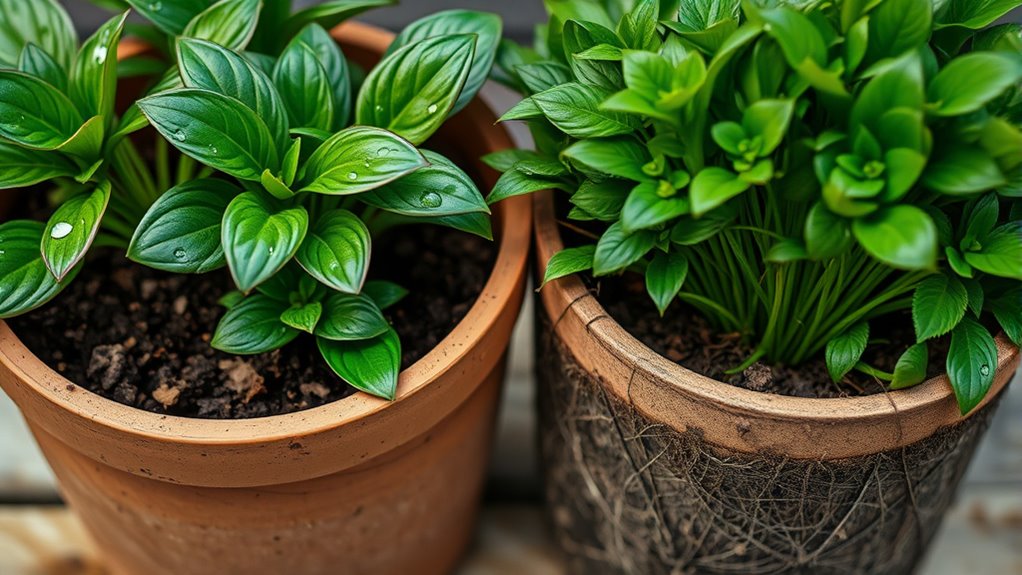
Miracid and Miracle-Gro are two popular fertilizers designed to promote healthy plant growth, but they serve different purposes. Miracid is formulated specifically for acid-loving plants, helping improve soil pH to support *ideal* plant health. It provides essential nutrients that enhance plant growth in soils with low pH levels. Miracle-Gro, on the other hand, is a versatile fertilizer that encourages rapid plant growth across a wide range of plants, regardless of soil pH. It mainly supplies nitrogen, phosphorus, and potassium to boost overall development. While Miracid is tailored for plants that thrive in acidic conditions, Miracle-Gro is more general-purpose. Understanding their different roles helps you select the right fertilizer based on your plant’s needs and soil pH, ensuring better growth and health. Additionally, choosing a fertilizer with the appropriate nutrient balance can significantly influence plant vitality and soil health.
Composition and Nutrients in Miracid
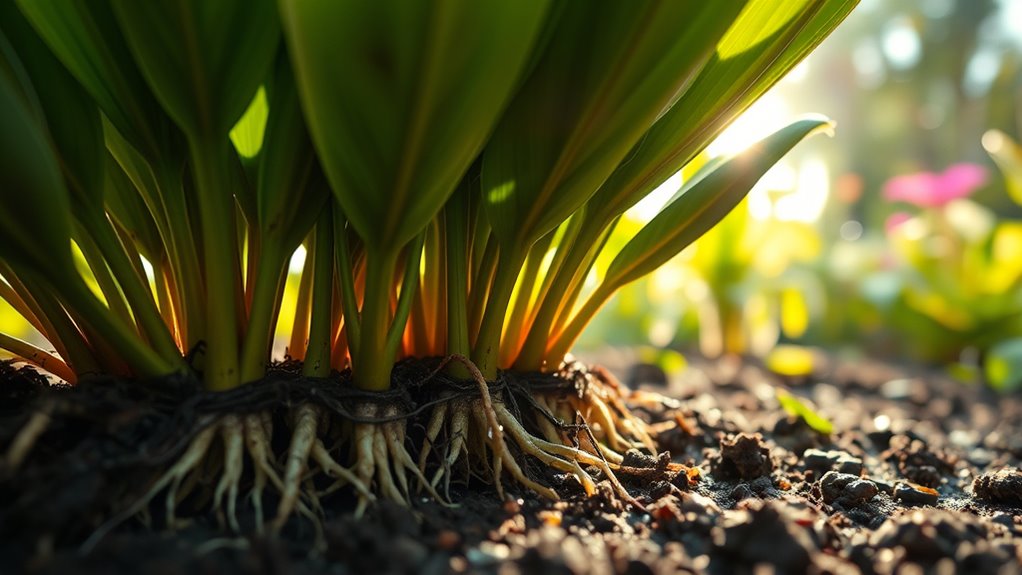
To support acid-loving plants effectively, Miracid’s composition is carefully formulated with essential nutrients that optimize soil conditions. It contains a balanced mix of nitrogen, phosphorus, and potassium, along with trace minerals crucial for plant health. Its key feature is the inclusion of iron and other micronutrients that help maintain the ideal soil pH for these plants. Miracid is designed to lower soil pH gradually, creating an environment where acid-loving plants thrive. This nutrient balance ensures your plants receive what they need for healthy growth without overloading the soil with excess nutrients. By maintaining proper soil pH and nutrient levels, Miracid promotes better nutrient uptake, stronger roots, and vibrant foliage. Understanding soil pH is essential for optimizing plant health and growth. Additionally, the formulation considers the importance of soil chemistry in creating the optimal environment for acid-loving plants. Proper soil amendments are key to adjusting soil conditions to suit these plants’ needs.
Composition and Nutrients in Miracle-Gro
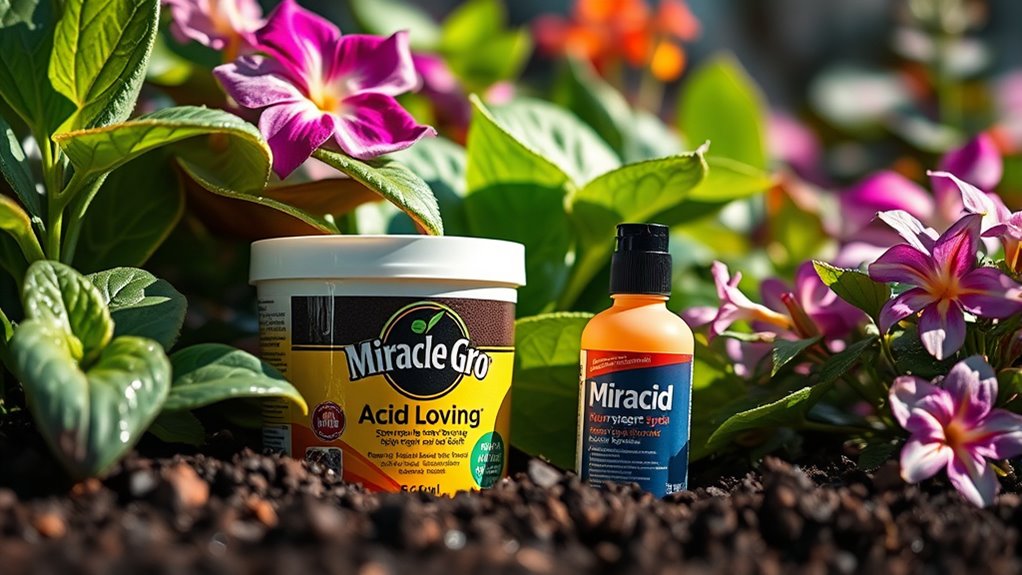
Have you ever wondered what makes Miracle-Gro effective for boosting plant growth? Its composition is designed to deliver quick nutrients and promote healthy development. The formula includes key nutrients like nitrogen, phosphorus, and potassium, essential for vigorous growth. Miracle-Gro also contains trace minerals that support overall plant health. Here’s what you should know: You can find Forsale 100 in many gardening stores, making it readily accessible for home gardeners. 1. Nutrient blend for rapid growth 2. pH adjustment properties for ideal nutrient uptake 3. Compatibility with most soil types 4. Easy-to-use liquid or granular forms
Miracle-Gro provides quick nutrients with essential minerals for healthy, vigorous plant growth.
This formulation makes it versatile for various plants, especially if your soil needs pH balancing. Keep in mind, its soil compatibility ensures it works well without harming your plants or disrupting soil chemistry. This combination helps your plants thrive with consistent feeding.
Suitability for Acid-Loving Plants
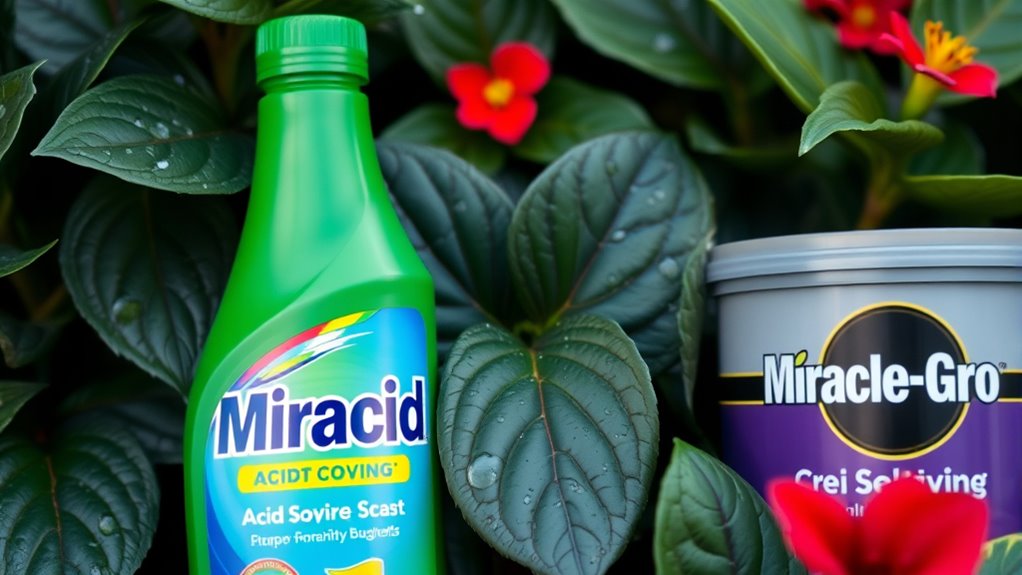
While Miracle-Gro is excellent for many plants, its suitability for acid-loving plants depends on its specific formulation. Regular Miracle-Gro products often have a neutral or slightly alkaline pH, which may not suit plants like azaleas or blueberries. If you’re considering Miracle-Gro for acid-loving plants, check whether it includes pH adjustment components or is specially formulated for acidic soil. Soil compatibility is essential; using a product not designed for acid-loving plants can hinder their growth. Miracle-Gro offers some formulations tailored to lower soil pH, but many are not ideal. Always verify the label to guarantee the product supports the necessary soil conditions. Proper soil compatibility and pH adjustment are critical for thriving acid-loving plants. Additionally, understanding soil pH and amendments can help you better tailor your plant care, especially when working with soil acidity levels. Being aware of soil pH balance can help you choose the most suitable fertilizers and amendments to promote healthy growth of acid-loving plants.
Application Methods and Usage Tips
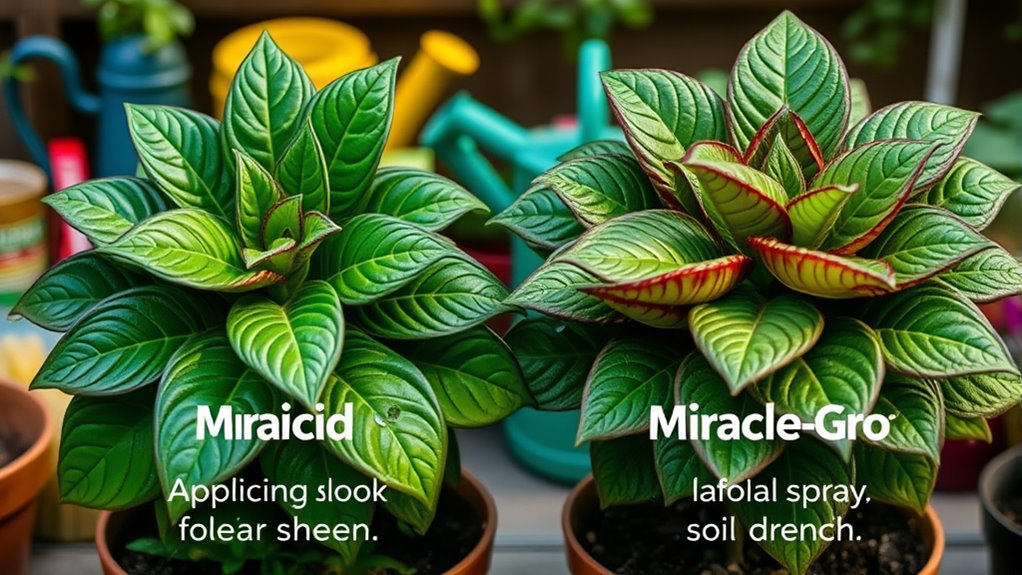
Proper application of Miracle-Gro is key to maximizing its benefits and avoiding plant damage. To do this effectively, follow these tips:
Proper Miracle-Gro use ensures healthy plants and optimal growth.
- Use the correct dilution ratio and apply consistently, respecting recommended application frequency to prevent overfeeding.
- Adjust soil pH if necessary, as Miracle-Gro works best in slightly acidic conditions for acid-loving plants.
- Water thoroughly after applying to help nutrients absorb and reduce the risk of salt buildup.
- Apply during the active growing season for ideal results, but avoid excessive use that can harm roots or alter soil pH.
- For optimal results, consider incorporating soil testing to monitor pH and nutrient levels, ensuring your acid-loving plants receive the best care. Regular testing can help maintain the right soil conditions for healthy plant growth.
Effectiveness and Results in the Garden
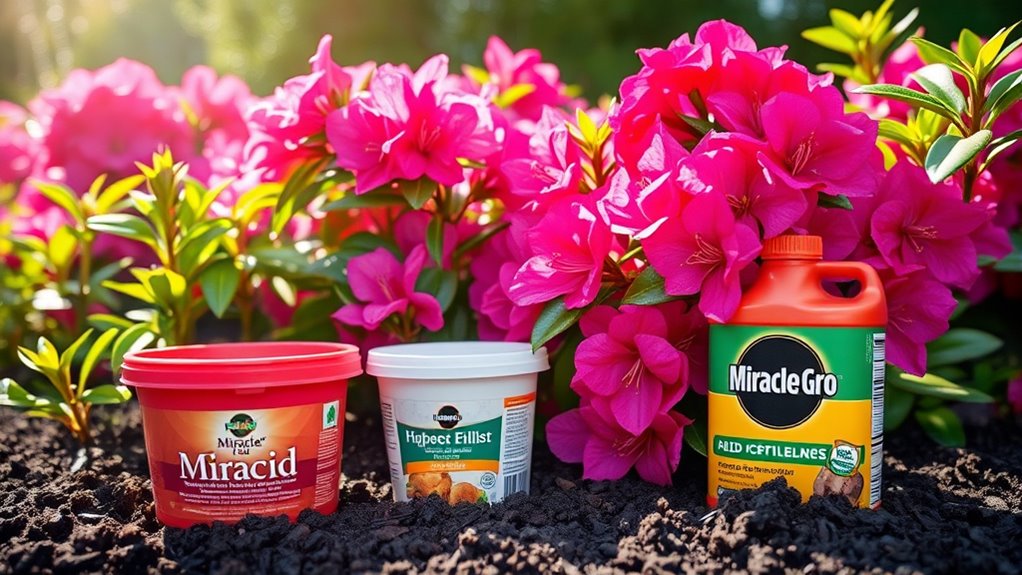
Miracle-Gro can deliver noticeable improvements in plant growth when used correctly, but its effectiveness depends on proper application and the specific needs of your garden. For acid-loving plants, pH adjustment is essential; Miracle-Gro’s formulations may not always provide the ideal acidity level, so you might need to supplement with organic options like peat moss or compost to maintain the desired pH. Miracid, designed specifically for acid-loving plants, tends to produce faster, more consistent results by directly addressing soil acidity. While Miracle-Gro can boost growth, its results may vary without precise pH control. Organic options often improve soil health over time, providing a sustainable way to enhance plant performance and achieve the desired results in your garden. Promoting soil health is crucial for long-term plant vitality and optimal growth.
Cost and Availability of Both Fertilizers
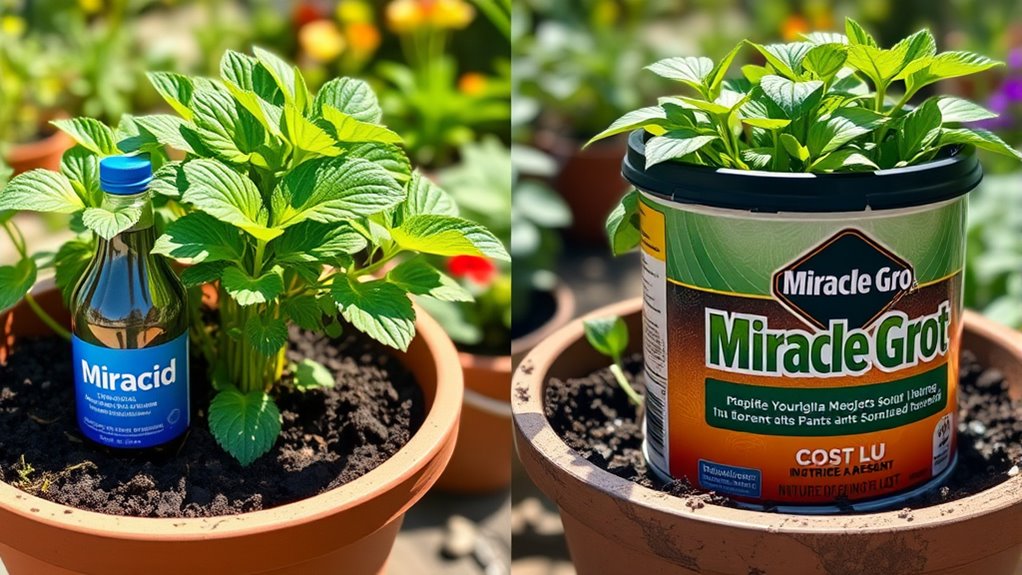
You’ll notice that Miracid and Miracle-Gro vary in price, with Miracle-Gro often being more affordable and widely available. Both products can be found at garden centers, big-box stores, and online retailers, making them easy to purchase. Accessibility depends on your location, but overall, Miracle-Gro offers more convenient options for most gardeners. Additionally, the home decor aspect of garden supplies can influence choices, as packaging and branding often reflect aesthetic preferences. Considering product availability can help you determine which fertilizer best fits your gardening needs and lifestyle, especially since zodiac sign compatibility may influence personal preferences in gardening styles.
Price Comparison
When comparing prices, Miracle-Gro generally costs more per unit than Miracid, but availability can vary depending on where you shop. Miracid tends to be affordable and easy to find, making it a popular choice for pH adjustment in acid-loving plants. Miracle-Gro is often pricier but offers a broader range of formulations, including organic alternatives. Here are some key points to contemplate:
- Miracid usually has a lower price per pound, making it budget-friendly.
- Miracle-Gro may cost more but provides options for organic gardening.
- Both fertilizers’ costs can fluctuate based on store promotions or bulk purchasing.
- Availability of organic alternatives is more common with Miracle-Gro, but pH adjustment options are also available in Miracid.
Your choice depends on your budget and whether organic options are important to you.
Purchase Locations
Both Miracid and Miracle-Gro are widely available at various retail locations, making them accessible options for gardeners. You can find them at garden centers, big box stores, and online retailers. Miracid, being specialized for acid-loving plants, is often stocked where soil acidity management is emphasized, but it may be less common than Miracle-Gro. Miracle-Gro is more readily available and versatile, suitable for many plant types, including those that prefer neutral or slightly acidic soil. When purchasing, consider your fertilizer storage options to keep the products fresh and effective. Price differences are reflected in their availability; Miracle-Gro tends to be more affordable and easier to find, while Miracid might be slightly more expensive and limited to specific stores. Additionally, understanding the electric power generation capabilities of related equipment can help you manage your garden’s energy needs efficiently.
Accessibility Factors
Accessibility plays a significant role when choosing between Miracid and Miracle-Gro, especially regarding their cost and availability. You should consider how easily you can find these fertilizers and how they impact your soil pH management and fertilizer longevity.
- Miracid is often available at specialty garden centers, but it can be pricier and less widespread.
- Miracle-Gro is generally more accessible, available at big-box stores and online, often offering better cost options.
- Price differences affect your budget, especially if you need large quantities for ongoing use.
- Availability influences how quickly you can boost soil pH or maintain it, directly impacting fertilizer longevity and plant health.
Both fertilizers’ accessibility can determine your gardening convenience and success.
Choosing the Right Fertilizer for Your Plants
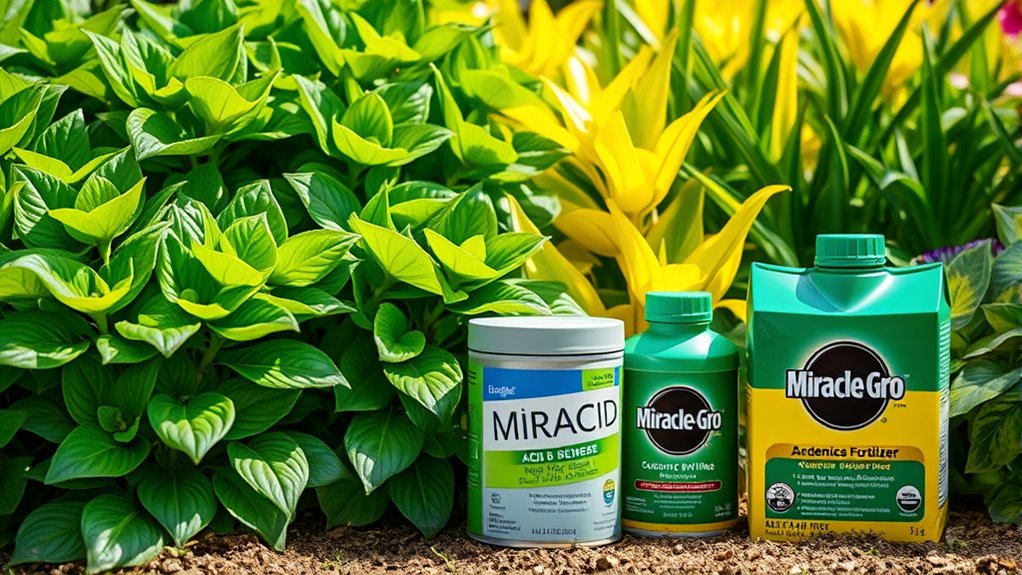
Choosing the right fertilizer for your plants depends on understanding their specific nutritional needs and growth stage. For acid-loving plants, pH adjustment is essential, so select fertilizers that maintain the proper acidity level, like Miracid. If you prefer organic options, look for natural fertilizers that enrich the soil without synthetic chemicals, supporting sustainable growth. Consider the plant’s age and development stage to determine whether it needs a higher nitrogen boost or phosphorus for flowering. Regular testing of soil pH helps you fine-tune your fertilizing strategy, ensuring your plants absorb nutrients effectively. Additionally, exploring the benefits of soil testing can help you better understand your plants’ needs and optimize their care. Whether you choose synthetic or organic fertilizers, always follow application instructions to prevent overfeeding. With the right approach, you’ll promote healthy, vibrant plants tailored to their unique needs.
Frequently Asked Questions
Can Miracid Be Used on Non-Acid-Loving Plants?
You can technically use Miracid on non-acid-loving plants, but it’s not recommended. Miracid is formulated for acid-loving plants, providing pH adjustment and fertilizer compatibility tailored to their needs. Using it on plants that prefer neutral or alkaline soils might disrupt their growth, leading to nutrient imbalances. For best results, choose a fertilizer suited to your plant’s pH requirements to guarantee proper nourishment and healthy development.
How Long Does It Take to See Results After Applying Miracid?
They say patience is a virtue, and with Miracid, you’ll see results in about 1 to 2 weeks. It works by enhancing soil pH adjustments and improving fertilizer absorption rates, so your acid-loving plants can thrive. You’ll notice healthier growth as the nutrients become more accessible. Keep in mind, consistent application helps maintain ideal soil conditions, ensuring your plants stay happy and vibrant over time.
Is Miracle-Gro Safe for Organic Gardening Practices?
You wonder if Miracle-Gro fits into your organic gardening practices. While it’s widely used and effective, Miracle-Gro isn’t organic-certified, so it may contain chemical residues that don’t align with organic standards. If maintaining organic certification is important to you, it’s better to choose organic fertilizers. Miracle-Gro’s chemical residues could compromise your garden’s organic status, so always check labels and opt for certified organic options when possible.
What Are the Environmental Impacts of Using Each Fertilizer?
Think about the environmental impact of your fertilizer choices—could they be causing more harm than you realize? Both Miracle-Gro and Miracid can contribute to environmental pollution and soil degradation if overused or misapplied. Miracle-Gro’s synthetic nutrients may leach into water sources, harming aquatic life, while Miracid’s acidity can alter soil health over time. Be mindful of how your gardening practices affect the environment and choose sustainably.
Are There Any Plants That Should Not Receive Miracid or Miracle-Gro?
Some acid-sensitive plants shouldn’t receive Miracid or Miracle-Gro, especially if fertilizer restrictions apply. You need to identify plants that are sensitive to pH changes or over-fertilization, like some ferns or certain orchids. Applying these fertilizers can harm them by causing nutrient imbalances. Always check your plant’s specific needs and avoid using these fertilizers if they’re listed as unsuitable for acid-sensitive plants to prevent damage.
Conclusion
Choosing between Miracid and Miracle-Gro is like picking the right key for your garden’s melody. If you have acid-loving plants, Miracid hits the right note with its tailored acidity and nutrients. Miracle-Gro, on the other hand, offers broad-spectrum growth support but may not suit your plants’ specific needs. So, consider your plants’ preferences and your gardening goals—your garden’s symphony depends on hitting the right notes.



